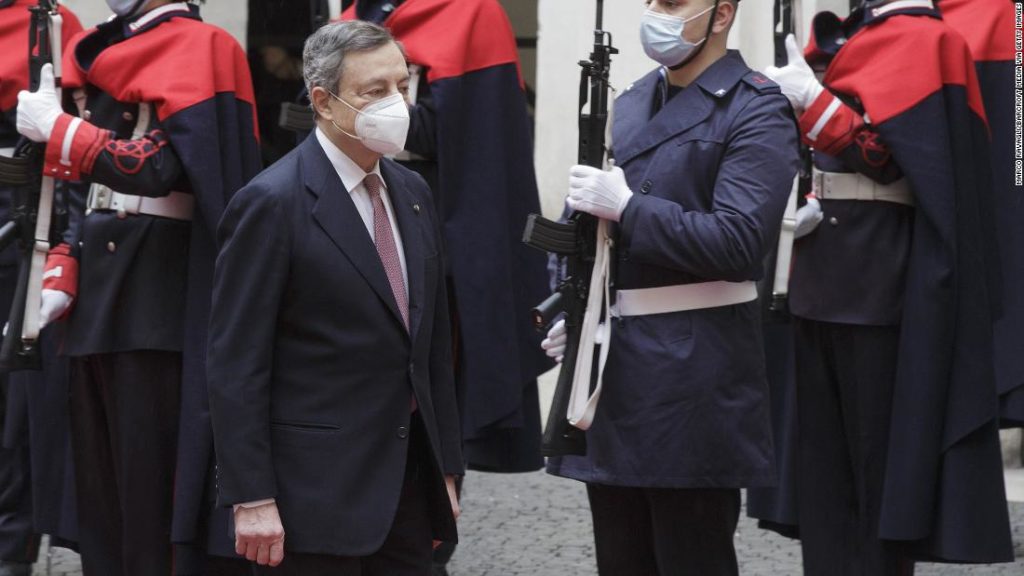
In 2012, the former European Central Bank chief won international acclaim after pledging to do “whatever it takes” to save the euro from collapse, a promise that served as a turning point in the continent’s sovereign debt crisis.
Now, Draghi faces a different, if equally daunting challenge: steering Italy’s recovery from the coronavirus pandemic.
Draghi takes the reins of an economy that was still struggling to recover from the 2008 global financial crisis when the pandemic hit. In 2019, economic output grew by just 0.3% over the previous year, compared to 1.6% for the European Union as a whole.
“Italy’s most important, fundamental problem is they haven’t grown enough for so many years,” said Erik Nielsen, chief economist at the Italian bank UniCredit.
“While some Member States are expected to see the distance to their pre-crisis output levels close by the end of 2021, others are forecast to take longer,” the Commission said in a forecast released last week. “This is particularly the case for Spain and Italy, which are not expected to reach those levels by the end of [2022].”
Yet Draghi has one advantage many of his predecessors lacked: a mandate to spend big. EU fiscal rules have been relaxed, richer member states are handing over money and Brussels is borrowing on Italy’s behalf.
Italy’s debt-to-GDP ratio stands at 154%, second in Europe only to Greece, and debt servicing costs a big chunk of the country’s budget. But the European Central Bank has made debt extremely cheap by pushing interest rates into negative territory and launching a massive bond-buying program, Nielsen noted. That gives Draghi significant leeway.
“He won’t have to implement draconian austerity programs,” Federico Santi, a senior analyst at Eurasia Group, said in a research note last week. “Rather, the new government will benefit from record-low borrowing costs and large-scale EU financing, while the EU remains supportive of fiscal stimulus for now.”
An ‘extraordinary’ opportunity
Just how Draghi chooses to spend on Italy’s recovery could define his tenure and the country’s future for years to come.
Nielsen said it’s crucial that Draghi immediately push for another round of spending and tax cuts to get the country’s economy back on track.
Embedded in this effort should be policies to address problems such as low participation in the labor force, which weighs on productivity, he emphasized. The government could encourage more people to seek employment by discounting taxes on second incomes, subsidizing child care and providing incentives for companies to offer part-time work.
“This is really low-hanging fruit for the Draghi government to pursue because it has been tested and implemented in virtually all other European countries,” Nielsen said in a note to clients on Sunday.
Draghi also needs to finalize a plan for how to spend hundreds of billions of dollars earmarked by the Europe Union for its recovery. Italy is among the biggest beneficiaries of the program, which will fund investments in sustainability and digitization.
“We have at our disposition the extraordinary resources of the European Union,” Draghi said last week. “We have the opportunity to do a lot for our country, with a careful eye on the future generation.”
Managing messy politics
More details are expected in the coming days ahead of Draghi’s first speech to Italy’s parliament. Already, though, there are fears that fractious politics could undermine the initial groundswell of support for the former central banker.
All of Italy’s political parties, apart from the right-wing Brothers of Italy, have said they will back the new government, and observers were heartened that Draghi’s cabinet includes a healthy mix of technocrats and politicians from across the spectrum.
“Even with broad support for Mr. Draghi’s reported list of priorities — health, jobs, business, schools and the environment — we don’t yet know many details, and there is plenty of scope for government infighting about what needs to be done about each of them,” Jack Allen-Reynolds, senior Europe economist at Capital Economics, said in a research note.
Paola Subacchi, professor of international economics at the Queen Mary University of London, said the best thing Draghi can do is commit to serving as prime minister for two years at most, forcing others to step up and craft sustainable policy.
You may also like
-
Afghanistan: Civilian casualties hit record high amid US withdrawal, UN says
-
How Taiwan is trying to defend against a cyber ‘World War III’
-
Pandemic travel news this week: Quarantine escapes and airplane disguises
-
Why would anyone trust Brexit Britain again?
-
Black fungus: A second crisis is killing survivors of India’s worst Covid wave

